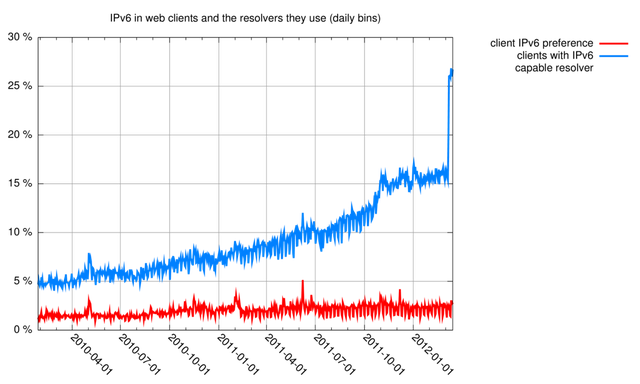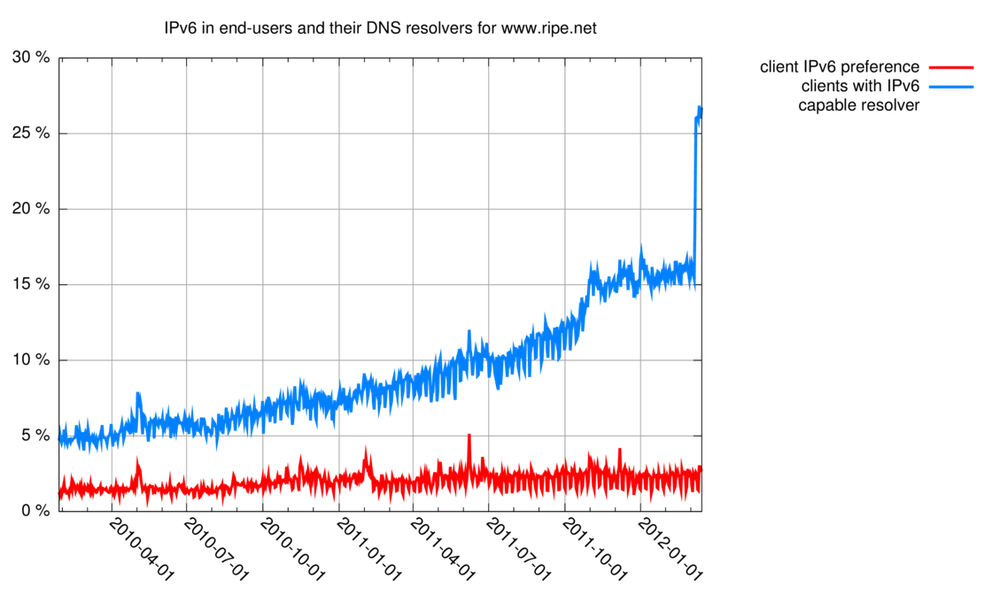We developed a script to measure IPv6 capabilities of DNS resolvers and clients two years ago. Recently we found some interesting trends in IPv6 capable DNS infrastructure.
In a recent post on RIPE Labs - Networks with IPv6 - One Year Later - we showed encouraging growth in the number of IPv6 enabled networks. But announcing an IPv6 prefix is only one of the first steps a network operator should take. For a full IPv6 deployment, IPv6 has to be enabled on other key parts of the infrastructure and made available to end users. One key piece of infrastructure for which we can measure IPv6 capabilities, are DNS resolvers. These are typically (in roughly 80% of the cases) located in the same network as the end users who are using them. The big exceptions are end-users that use public DNS resolving services, like OpenDNS and Google Public DNS .
I've been tracking the IPv6 capabilities of the DNS resolvers that are used by visitors to www.ripe.net since early 2010. See Measuring IPv6 at Clients and Caching Resolvers for earlier results (March 2010). Two key metrics used here are the IPv6 preference of end users and the IPv6 capability of the DNS resolvers used by these end users. The IPv6 preference of end users measured here indicates the percentage of clients that connect over IPv6 to www.ripe.net, which is dual-stacked. The IPv6-capable resolvers measured here indicate the percentage of clients that use a DNS resolver that is capable of using IPv6 for DNS resolution (more details can be found in Measuring IPv6 at Clients and Caching Resolvers - Methodology ). The intuition here is that network operators will first enable IPv6 on their caching DNS resolvers, and in later steps of IPv6 deployment roll it out to end users.
Recently I saw noticeable increases in IPv6 capabilities of DNS resolvers, as shown in the blue line in Figure 1. Note that the www.ripe.net-audience is biased towards network operators. That means the IPv6 capability of typical end-users is probably lower than what I measure here.

As you can see, over 25% of end users that visit www.ripe.net currently use a resolver that is IPv6 capable. This is far more then the 2-3% of end users that really use IPv6 to visit www.ripe.net (as shown in the red line in Figure 1).
The gap between IPv6 capabilities of end users and the resolvers they use is widening over time. I think this is indicative of a frequently mentioned problem with deploying IPv6 to end-users: The lack of IPv6 capabilities in many (older) customer-premises equipment (CPE), and/or the economics of replacing old CPE. (See also the IPv6 CPE Survey on RIPE Labs). However, it does show operators extending the IPv6 capabilities of their networks, and why would they do that, other then to eventually provide this to their end-users?
Looking at the resolvers time series (blue line) in Figure 1 in more detail, there are two increases that jump out. One around November 2011 and one early March 2012. Table 1 shows the top 3 networks I see with IPv6 capable networks for a sample day each month since October 2011. As you can see, the increase around November can be attributed to Deutsche Telekom enabling more of their DNS resolvers to resolve over IPv6, and the increase in March is due to Google Public DNS. Note that the client-facing part of Google Public DNS has been accessible over IPv6 at least since June 2011 , the change visible in Figure 1 is due to the DNS resolving part of this service being able to access DNS servers over IPv6. Both the October and March jumps show that big players are making progress on their IPv6 deployments.
| Date | Count | IPv6 prefix | Network Name |
|---|---|---|---|
| 2011-10-08 | 93 | 2a01:e00::/32 | Free.fr |
| 70 | 2003:180::/32 | Deutsche Telekom | |
| 70 | 2001:558::/32 | Comcast | |
| 2011-11-08 | 619 | 2003:180::/32 | Deutsche Telekom |
| 144 | 2a01:e00::/32 | Free.fr | |
| 136 | 2001:558::/32 | Comcast | |
| 2011-12-08 | 538 | 2003:180::/32 | Deutsche Telekom |
| 149 | 2a01:e00::/32 | Free.fr | |
| 146 | 2001:558::/32 | Comcast | |
| 2012-01-08 | 514 | 2003:180::/32 | Deutsche Telekom |
| 132 | 2a01:e00::/32 | Free.fr | |
| 126 | 2001:558::/32 | Comcast | |
| 2012-02-08 | 606 | 2003:180::/32 | Deutsche Telekom |
| 177 | 2a01:e00::/32 | Free.fr | |
| 176 | 2001:558::/32 | Comcast | |
| 2012-03-08 | 2237 | 2a00:1450::/32 | |
| 557 | 2003:180::/32 | Deutsche Telekom | |
| 157 | 2001:558::/32 | Comcast |
Table 1: Top 3 networks where we see IPv6 enabled caching resolvers for a sample day per month
Conclusion
We should not be overly optimistic about IPv6 deployment worldwide. There is a widening gap between IPv6-enabled DNS resolvers and end-users, and the real number of IPv6 enabled end-users is much lower then what we measure on www.ripe.net. This number is currently at around 0.4-0.5% according to measurements by APNIC that the RIPE NCC cooperates in and Google's measurements .
That being said, the Google measurements show encouraging growth. And both the IPv6-enabled networks and IPv6-enabled DNS resolvers growth curves as shown in the figure above, show broad progress towards full IPv6 adoption.
We're getting there ... slowly.






Comments 0
The comments section is closed for articles published more than a year ago. If you'd like to inform us of any issues, please contact us.